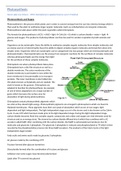Other
BTEC Level 3 Applied Science Unit 10 Assignment C - Photosynthesis
- Course
- Institution
BTEC Level 3 Applied Science Unit 10 Assignment C - Explore the factors that can affect the pathways and the rate of photosynthesis in plants. I achieved a DISTINCTION for this assignment!
[Show more]



